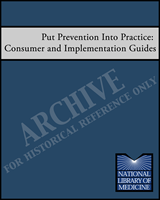NCBI Bookshelf. A service of the National Library of Medicine, National Institutes of Health.
This publication is provided for historical reference only and the information may be out of date.
Put Prevention Into Practice (PPIP) is a national campaign to improve the delivery of clinical preventive services such as screening tests, immunizations, and counseling for health behavior change. Central to that effort is the Clinician's Handbook of Preventive Services (2nd Edition, 1998). The following excerpts present practical instructions for incorporating prevention into office and clinic routines.
Contents
- Child Health Guide
- Personal Health Guide
- How to Use the Personal Health Guide
- Blood Pressure
- Immunizations
- Cholesterol
- Weight
- Colorectal Cancer
- Oral Health Care
- Preventive Care For Women
- Additional Preventive Care
- Tobacco Use
- Physical Activity
- Nutrition
- Depression
- Safety
- HIV and AIDS
- Family Planning
- Alcohol and Other Drug Use
- For More Information
- Put Prevention Into Practice
- Key Records
- Staying Fit at 50+
- Implementing Preventive Care: 10 Steps: Implementation Guide
- Introduction
- 1. Assess the Need for a New System
- 2. Assess Readiness to Make a Systems Change
- 3. Enlist Staff Support
- 4. Perform a Chart Audit
- 5. Establish Preventive Care Protocols
- 6. Analyze Service Delivery and Patient Flow
- 7. Use Basic Tools
- 8. Use Other Helpful Tools
- 9. Delegate Tasks and Staff Roles
- 10. Perform Follow-up Evaluations
- In Summary
- Clinical Scenario
- Internet Citation
- Put Prevention Into Practice: Consumer and Implementation GuidesPut Prevention Into Practice: Consumer and Implementation Guides
Your browsing activity is empty.
Activity recording is turned off.
See more...
